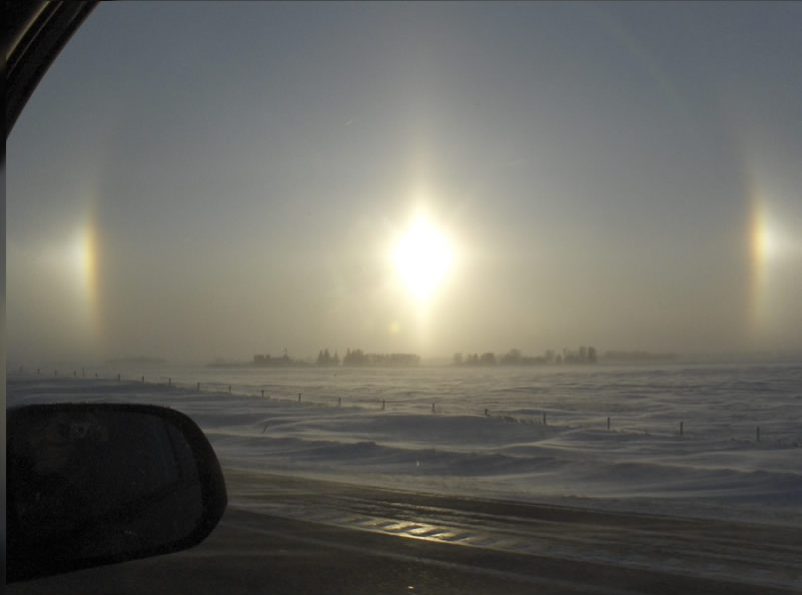Solstice Halos
Solstice Halos: A Spectacular Atmospheric Phenomenon
Solstice halos are a mesmerizing atmospheric optics phenomenon that occurs during the winter solstice. These captivating displays of light are caused by the interaction of sunlight with ice crystals suspended in the atmosphere. While the existing content provides a brief glimpse into this phenomenon, let's dive deeper into the intricacies and beauty of solstice halos.
During the winter solstice, when the Earth is tilted furthest away from the Sun, the sunlight passes through a thicker layer of the atmosphere, creating the perfect conditions for the formation of halos. These halos appear as luminous rings encircling the Sun and are often accompanied by other optical phenomena, such as sundogs and sun pillars.
Sundogs, also known as parhelia, are bright spots that appear on either side of the Sun. They are formed when sunlight is refracted by hexagonal ice crystals in the atmosphere. The light is bent at an angle of approximately 22 degrees, resulting in the formation of these dazzling patches of light. Sundogs can be seen as miniature rainbows, with vibrant colors ranging from red to violet.
In addition to sundogs, solstice halos are often accompanied by a 22-degree halo. This circular halo surrounds the Sun and is caused by the refraction and reflection of sunlight by ice crystals. The diameter of this halo measures approximately 22 degrees, hence its name. The sight of this ethereal ring of light is truly awe-inspiring and adds to the enchantment of solstice halos.
Another fascinating phenomenon that can be observed during solstice halos is the presence of sun pillars. These vertical columns of light extend above and below the Sun and are created when light is reflected off horizontally oriented ice crystals. Sun pillars can give the illusion of pillars reaching towards the heavens, adding a mystical element to the overall spectacle.
The combination of sundogs, 22-degree halos, and sun pillars during solstice halos creates a classic display of atmospheric optics. These phenomena are a testament to the intricate interplay between sunlight and ice crystals in the atmosphere. The intricate geometry of these ice crystals determines the shape and appearance of these optical marvels.
To fully appreciate the beauty of solstice halos, it is essential to observe them in regions with cold climates and abundant ice crystals in the atmosphere. The winter solstice provides the perfect opportunity to witness these stunning displays, as the low angle of the Sun allows for optimal refraction and reflection of light.
As with many atmospheric optics phenomena, capturing solstice halos on camera can be a challenge. However, with patience and the right equipment, photographers have been able to immortalize these breathtaking displays. The image accompanying this article, captured by Kimberly MacLin in Southern Minnesota, showcases the splendor of solstice halos on the Winter Solstice.
In conclusion, solstice halos are a captivating atmospheric optics phenomenon that occurs during the winter solstice. These displays of light, characterized by sundogs, 22-degree halos, and sun pillars, showcase the intricate interaction between sunlight and ice crystals in the atmosphere. Witnessing the beauty of solstice halos firsthand is a truly magical experience that reminds us of the wonders of our natural world.

Halos imaged by Kimberly MacLin (site) in Southern Minnesota on the Winter Solstice, December 21. ©M Kimberly MacLin, shown with permission.
The icy sun is flanked by diamond dust sundogs each tapering away into a 22 degree halo.
A faint parhelic circle courses across the sun parallel to the horizon. Perpendicular to it are upper and lower sun pillars.
A classic display.
Note: this article has been automatically converted from the old site and may not appear as intended. You can find the original article here.
Reference Atmospheric Optics
If you use any of the definitions, information, or data presented on Atmospheric Optics, please copy the link or reference below to properly credit us as the reference source. Thank you!
-
<a href="https://atoptics.co.uk/blog/solstice-halos/">Solstice Halos</a>
-
"Solstice Halos". Atmospheric Optics. Accessed on December 22, 2024. https://atoptics.co.uk/blog/solstice-halos/.
-
"Solstice Halos". Atmospheric Optics, https://atoptics.co.uk/blog/solstice-halos/. Accessed 22 December, 2024
-
Solstice Halos. Atmospheric Optics. Retrieved from https://atoptics.co.uk/blog/solstice-halos/.